Bio final
5.0(2)
5.0(2)
Card Sorting
1/31
Earn XP
Description and Tags
Study Analytics
Name | Mastery | Learn | Test | Matching | Spaced |
|---|
No study sessions yet.
32 Terms
1
New cards
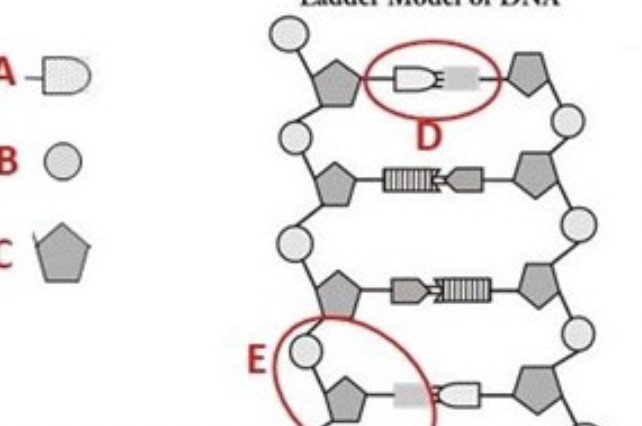
Label each letter shown
Nucleotide E
Nitrogenous base A
Base pair D
Phosphate B
3’ end of DNA strand F
Hydrogen bonds G
Deoxyribose C
Nitrogenous base A
Base pair D
Phosphate B
3’ end of DNA strand F
Hydrogen bonds G
Deoxyribose C
2
New cards
Create a mismatch mutation in your strand by pairing two purines (A & G) or two pyrimidines (T & C). What information from Rosalind Franklin’s data ruled this arrangement out (as a hypothetical structure for DNA)?
1. Rosalind Franklins data ruled that in any base that has 2 rings it must be connected to a base that has 1, this leads to a uniformed structure of the diameter.
2. the correct formation is (a=T) and G=C)
3
New cards
What is DNA replication
the process of making DNA that must occur before a cell can divide into 2 cells
4
New cards
Explain the process of DNA replication
Each chromosome gets one new strand (DNA polymerase) along with its parent strand. DNA Polymerase moves along and puts together the covalent bonds between these building blocks (the nucleotides). They are then able to open up and unwind, separating their hydrogen bonds between the parent strands which serve as a template for the synthesis of the daughter strand which is why it is called semi-conservative because one of the strands is conserved in this process.
5
New cards

Label Each of these letters
Q- 3’ of the mRNA
P-RNA Polymerase
O- mRNA
L-Transcription Initiation Site
M- 5’ cap
R- Transcription termination site
N-DNA template strand
P-RNA Polymerase
O- mRNA
L-Transcription Initiation Site
M- 5’ cap
R- Transcription termination site
N-DNA template strand
6
New cards
Decode this coding segment TGACTTAGGCCTACCGACC
ACUGAAUCCGGAUGGCUGG
7
New cards
When a mutation occurs that changes the amino acid group but they’re still in the same group (same charge and size) what occurs?
This mutation changes amino acid #9 from Lys to Arg which are very similar (both have positively charged side chains), so it might not impact the tertiary structure at all.
8
New cards
When a mutation occurs that changes the polarity of the two amino acids (changing from polar to non polar) what occurs.
This mutation changes amino acid #3 from Cys to Ser which prevents the disulfide bond from forming. This completely changes the tertiary structure of the protein and would result in a non-functioning form. Significant increased risk of cancer.
9
New cards
When can transcription occur
when several transcription factors have bound to the promoter.
10
New cards
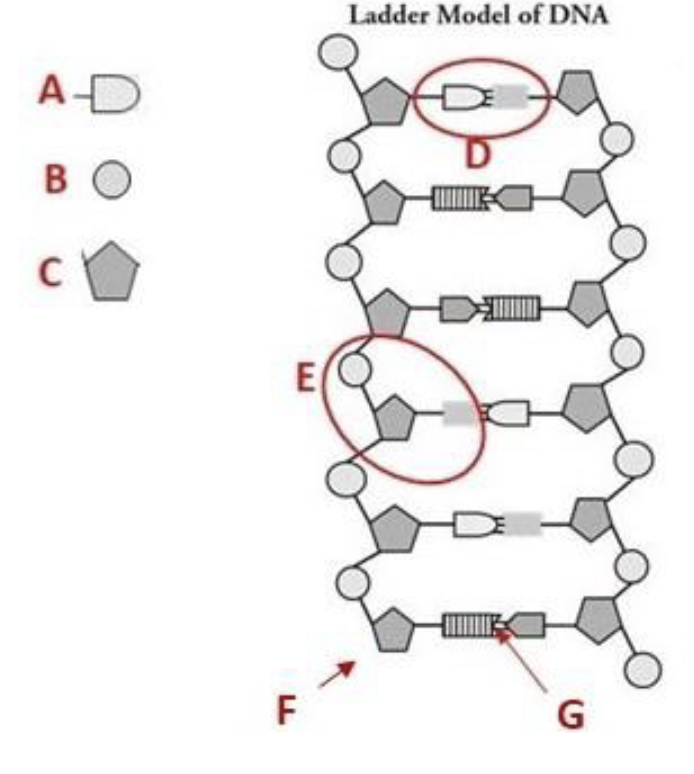
Label each of the letters shown
E- Nucleotide
A- Nitrogenous Base
D- Base Pair
B- Phosphate
F- 3’ end of DNA strand
G- Hydrogen Bond
C- Deoxyribose
A- Nitrogenous Base
D- Base Pair
B- Phosphate
F- 3’ end of DNA strand
G- Hydrogen Bond
C- Deoxyribose
11
New cards
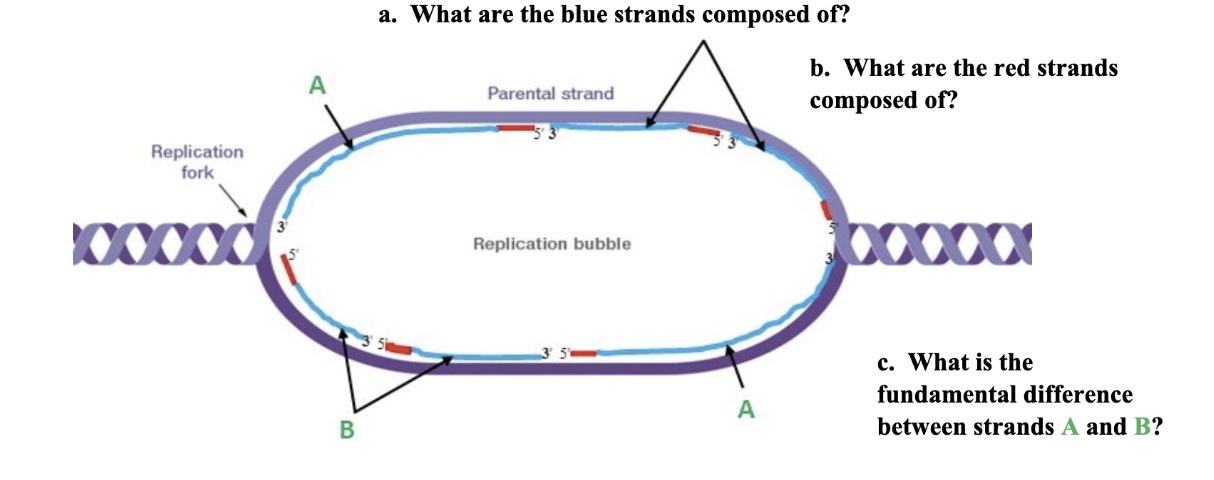
Label each section and answer the questions
A- New DNA B- RNA primer C- A is called “continuous strand synthesis” because it will continue to be synthesized as the helix is unwound. B indicates an Okazaki fragment and “discontinuous synthesis” because it can only be initiated when helicase has unwound a segment of the DNA. This limitation is because DNA polymerase can only move in the 5\` to 3\` direction.
12
New cards
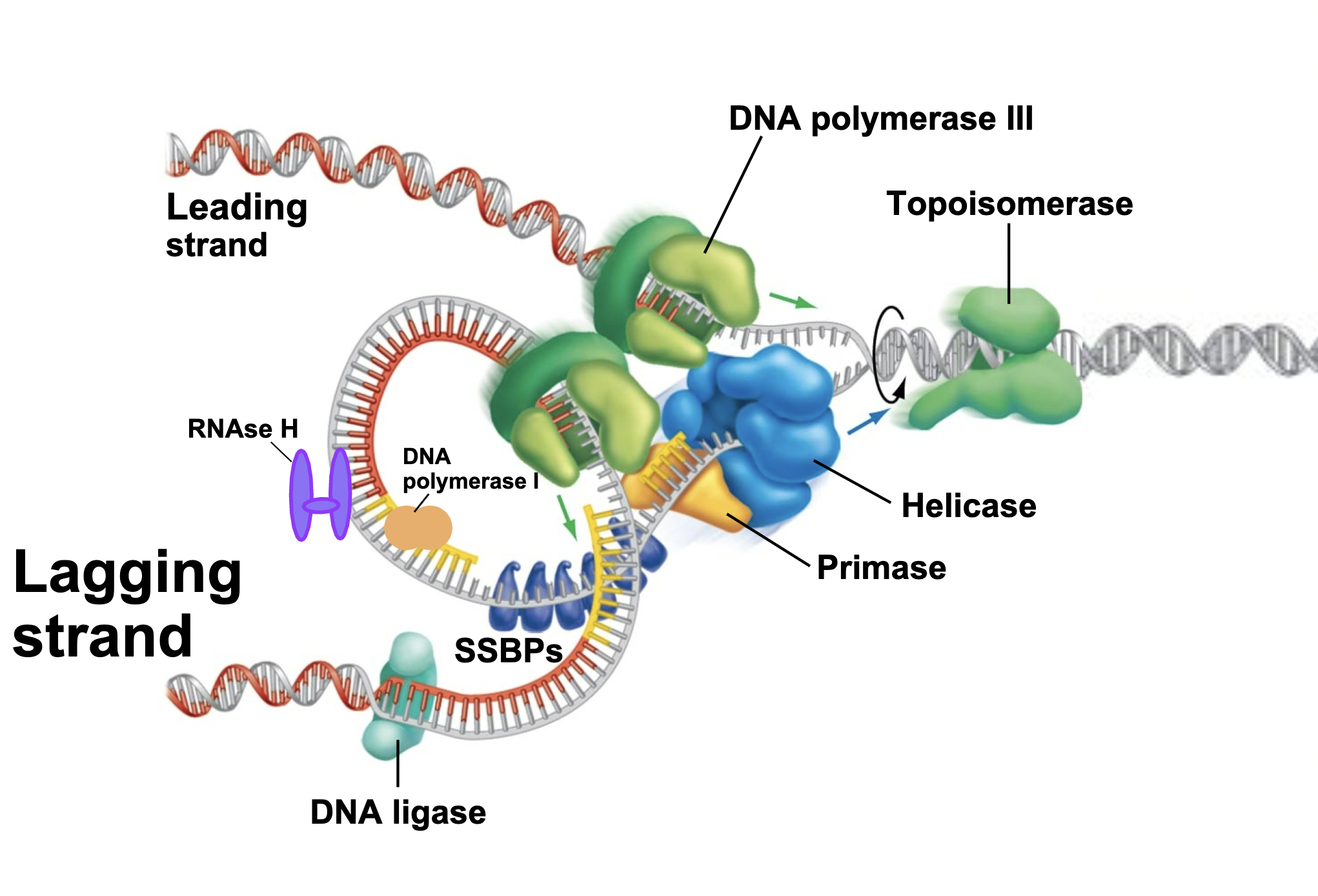
Explain the Function of Primase, DNA Polymerase III, and Topoisomerase
Primase puts in the RNA bases so the process can start. Then DNA Polymerase III can add onto the 3’prime end and add on but DNA Polymerase III can only move from the 5’ prime end to the 3’prime directions. So on the other strand it has to occur in the opposite direction. Topoisomerase can cut through one of the other strands in order to let the tension be released and close it back up.
13
New cards
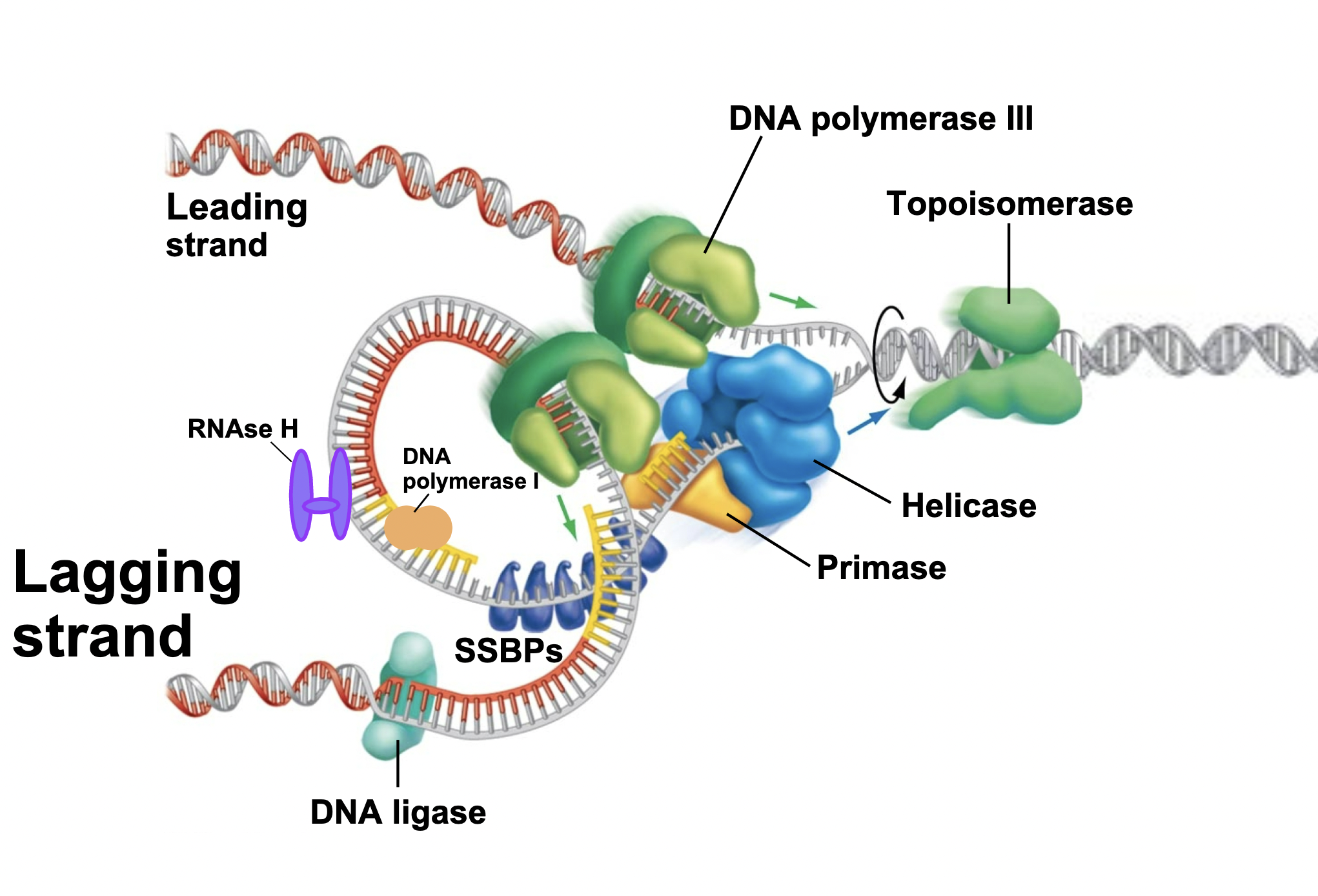
Explain the Function of Helicase and SSBPs and Primase and Primase DNA Ligasin the second part
Helicase is a protein that breaks the hydrogen bonds between the 2 strands. SSbps is a single-strand binding protein that helps keep the strands from unraveling. Then later on primase, on the other side of the replication bubble is synthesized in fragments, so primase comes in the DNA polymerase which comes to an Okazaki fragment where a new protein comes in called RNAse H which removes the primer, and DNA polymerase pulls in the correct material. Then DNA ligase connects the two ends together.
14
New cards
Where does the process of DNA Replication occur
During S-phase (proofreading), this is because DNA Polymerase makes numerous mistakes, if left unpaired this would yield 60,000 mutations per cell.
15
New cards
What is the role of DNA Polymerase? Be specific. (What are the substrates? What bond is broken, and what bond is made?)
DNA polymerase catalyzes the formation of the covalent bond between the 3\` OH group of the ribose in the growing daughter strand and the phosphate group of the incoming nucleoside triphosphate. A high-energy phosphate bond of the incoming nucleotide is broken and the energy is coupled to making the covalent bond between the ribose and the remaining phosphate on the nucleotide (called a “phosphodiester bond”). Notice this is “condensation synthesis”, so water is a product, as is PPi.
16
New cards
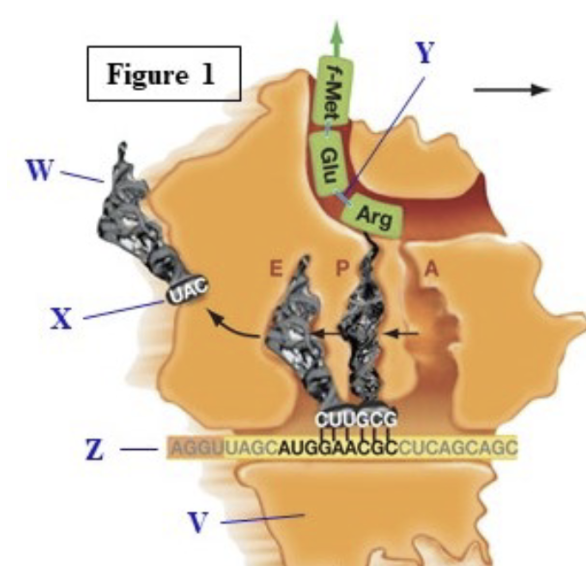
Label each letter
__*Y* Peptide Bond __X__ Anticodon __Z__mRNA __W__ tRNA __*V*__ small ribosomal subunit
17
New cards
The “E” site in a ribosome
holds the tRNA that just delivered its amino acid to the growing polypeptide in the P site.
18
New cards
What is the P site in a ribosome
The P-site (for peptidyl) is the second binding site for tRNA in the ribosome. the P-site holds the tRNA which is linked to the growing polypeptide chain.
19
New cards
What is the A site in a ribosome
The A-site (A for aminoacyl) of a ribosome is a binding site for charged t-RNA molecules during protein synthesis. the A-site is the first location the t-RNA binds during the protein synthesis process
20
New cards
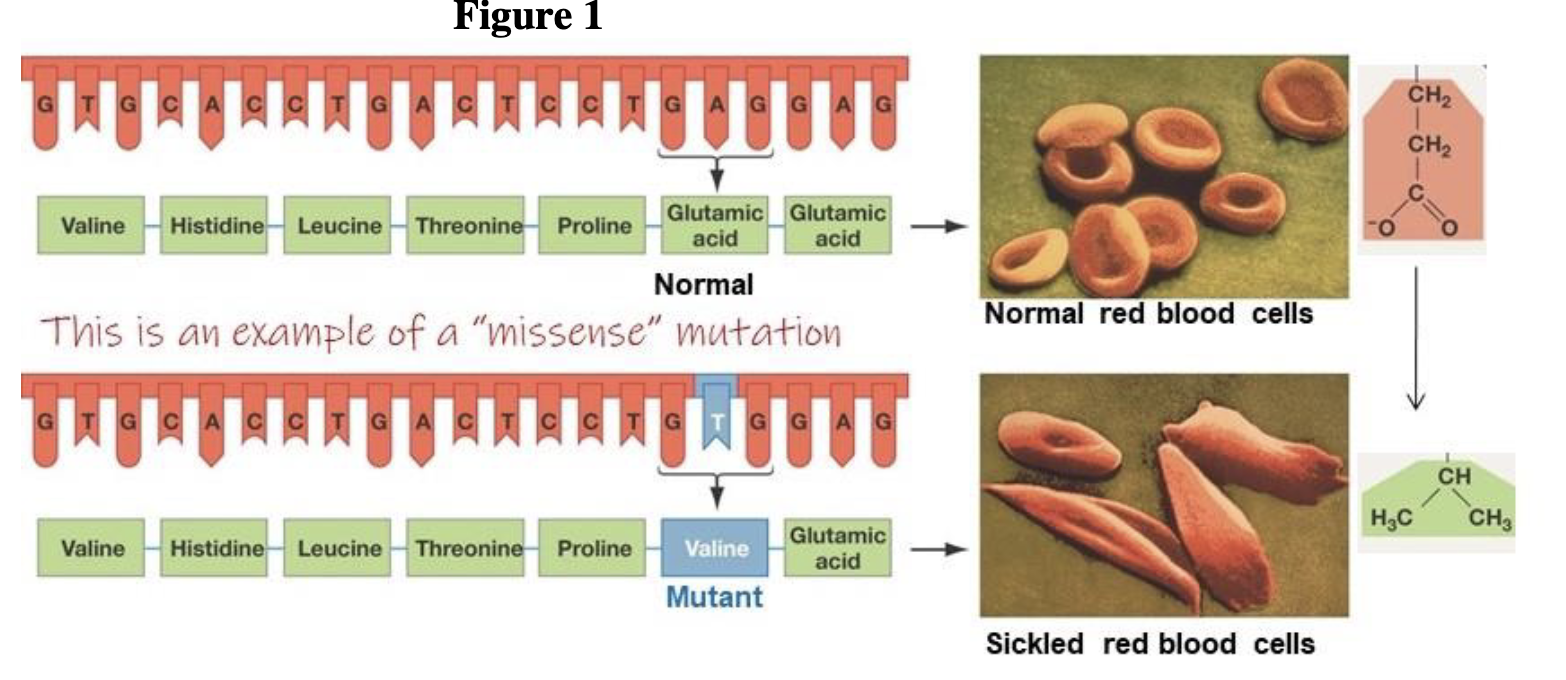
explain how a single base substitution can lead to misshapen red blood cells. Use your knowledge of the relationship between the primary, tertiary and quaternary structure of proteins to answer the question.
A single base substitution (A -> T) has a dramatic impact it changes the primary structure. A negatively charged amino acid is switched for a nonpolar one. This changes the tertiary structure of the subunits in such a way that the quaternary structure of hemoglobin is impacted.
21
New cards
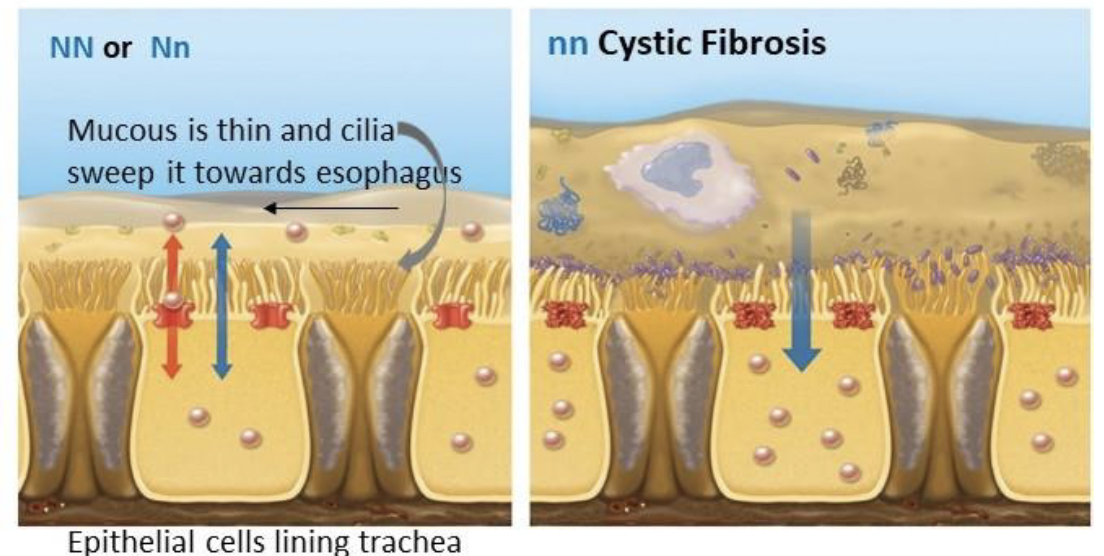
How does the CFTR protein regulate the viscosity of the mucous that lines the respiratory system? Your answer should reflect an understanding of osmosis and the role of the ciliated cells that line the trachea.
As described in the lecture, the CFTR protein moves Cl- into the mucous, Na+ follows through open channels and this creates an osmotic gradient favoring net osmosis of water out of the epithelial cells. In other words, it thins or dilutes the mucous so that the beating cilia are effective at sweeping it up to be swallowed. The highly acidic \\n (pH 2) stomach destroys bacteria and viruses.
22
New cards
Darker skin protects skin cells from UV radiation. So why aren’t all humans dark-skinned?
Melanin inhibits Vitamin D synthesis. In conditions of high UV exposure Vitamin D synthesis is not inhibited, but in low light regions dark-skinned individuals are at risk for vitamin D deficiency. Interestingly, some indigenous people (like the Inuit/Yupik people in Alaska) in low light regions have dark skin but their diets are rich in vitamin D. In this case there was no selective pressure against high melanin production
23
New cards
How could the availability of milk have provided strong favorable selection for lactase persistence in pastoral human populations 10,000 years ago?
There are many possibilities.• Alternative source of fluids if there is a drought or if water supply is contaminated.
• Milk is a highly nutritious food, so if crops are destroyed and meat availability is low or contaminated the ability to utilize milk could prevent famine.
• Milk is a highly nutritious food, so if crops are destroyed and meat availability is low or contaminated the ability to utilize milk could prevent famine.
24
New cards

Explain why the following mutation, though detrimental, is harmless: UV light causes a mutation in an epithelial cell that destroys the transcription initiation site of the gene encoding hexokinase.
The gene will not be transcribed (or processed or translated).
This allele will not generate hexokinase. It depends on the condition of the hexokinase gene on the homologous chromosome and whether these alleles show incomplete dominance. In worst case scenario, the epithelial cell dies. The organism will not be affected by the death of one epithelial cell.
This allele will not generate hexokinase. It depends on the condition of the hexokinase gene on the homologous chromosome and whether these alleles show incomplete dominance. In worst case scenario, the epithelial cell dies. The organism will not be affected by the death of one epithelial cell.
25
New cards
Our concern regarding exposure to mutagenic agents over our lifetime is not that cells might be destroyed, but that they might grow. Mutagenic agents might cause cells to replicate, to return to cell cycle or to stay in the cell cycle when they shouldn’t. Although no single mutation can cause cancer, provide an example of a an epithelial cell that destroys the transcription initiation site of the gene encoding hexokinase. mutation that might contribute to the progression of cancer.
A mutation in a gene encoding a growth factor receptor such that it remains in the active form even in the absence of growth factors. Or A mutation in the regulatory region of a growth factor gene such that it is over expressed.
26
New cards
what is the first step of protein synthesis, explain it
transcription, first Rna Polymerase binds to the promoter region, and then causes 2 DNA strands to separate. Then it begins to add nucleotides to the growing MRNA. RNA polymerase synthesizes mrna from the 5’ to 3’ end but reads from the 3’ to 5’ direction. Then termination occurs, the RNA polymerase the MRNA strand seperate from the DNA template. The Poly-A- Polymerase caps the 3’ end of the mrna strand (known as the poly-a-tail). Then removes the introns during RNA splicing to leave with a complete mrna Strand.
27
New cards
What is the second step of protein synthesis, explain it
Translation, when the mrna strand is synthesized in the nucleus it leaves and enters the cytosol. It enters the ribosome and matches the start codon (AUG) with its anticodon(UAC). then a trna molecule enters the P site and a covalent bond will form between the 2 amino acids. The trna molecule will move from the P site to the E site and lose an amino acid , so we have a chain of amino acids leaving the ribosome. Then when a stop codon is read it causes a release factor to enter the A site. This causes the large and small ribosomal subunits to disassemble. The protein then leaves the ribosome.
28
New cards
What would you expect to be the result of a mutation that destroys the TATA box in the gene encoding galactose isomerase in a cell of an early human embryo?
All descendent cells would carry the mutation, however, since there are two copies of the gene the cells may have one working copy in which case the baby would still be able to convert galactose to glucose. The child would be a “carrier” for the disease “galactosemia”.
29
New cards

Identify each of the large chromosomal mutations indicated above
study the images
30
New cards
What would be the result of a mutation in an adult somatic cell leading to an amino acid substitution affecting the active site of the PFK protein?
a. Death (of the individual) b. Death of the cell c. It depends on whether the homolog has a functioning copy of the PFK gene d. It depends on whether both copies are needed for full functioning of glycolysis e. b, c, and d are all possible (anything but choice a.)
a. Death (of the individual) b. Death of the cell c. It depends on whether the homolog has a functioning copy of the PFK gene d. It depends on whether both copies are needed for full functioning of glycolysis e. b, c, and d are all possible (anything but choice a.)
e. b, c, and d are all possible (anything but choice a.)
31
New cards
Compare the organization of the insulin gene in a blood cell with its organization in a pancreatic cell.
The insulin gene in a blood cell would be in a region of highly condensed chromatin because it is never transcribed. In a pancreatic cell it would need to be accessible because it is frequently expressed
32
New cards

What do the blue and white beads represent
blue- phosphate group white- ribose